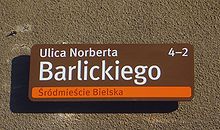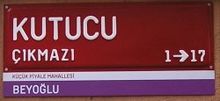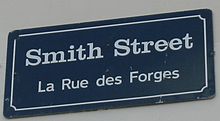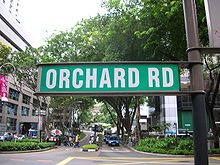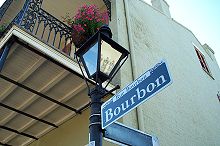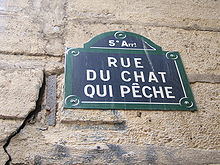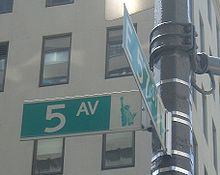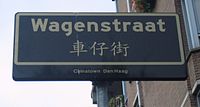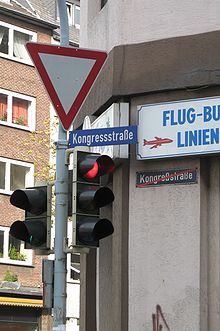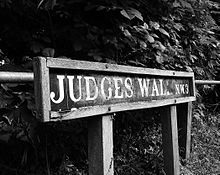- Street or road name
-
For other uses, see Street name (disambiguation).
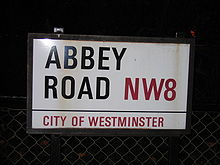 Abbey Road in London
Abbey Road in London
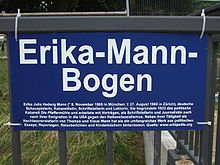 Street sign in Hamburg, Germany
Street sign in Hamburg, Germany
A street name or odonym is an identifying name given to a street. The street name usually forms part of the address (though addresses in some parts of the world, notably most of Japan, make no reference to street names). Buildings are often given numbers along the street to further help identify them.
Names are often given in a two-part form: an individual name known as the specific, and an indicator of the type of street or area, known as the generic.[verification needed] Examples include "Main Road", "Fleet Street" and "Park Avenue". The type of street stated, however, can sometimes be misleading: a street named "Park Avenue" need not have the characteristics of an avenue in the generic sense. Some streets are given a name without a street type designation. The Mall, for example, is the name of various famous streets around the world. On the other hand, some streets have only a generic name, such as Broadway.
A street name can also include a direction (the cardinal points east, west, north, south, or the quadrants NW, NE, SW, SE) especially in cities with a grid-numbering system. Examples include "E Roosevelt Boulevard" and "14th Street NW". These directions are often (though not always) used to differentiate two sections of a street. Other qualifiers may be used for that purpose as well. Examples: upper/lower, old/new, or adding "extension".
"Main Street" and "High Street" are common names for the major road in the middle of a shopping area in the United States and the United Kingdom, respectively. Fore Street is often used, instead of or as well as High Street, in the West of England. The most common street name in the US is "2nd" or "Second".[1]
Contents
Etymologies
The etymology of a street name is sometimes very obvious, but at other times it might be obscure or even forgotten.
In the United States, most streets are named after numbers, landscapes, trees (a combination of landscapes and trees such as "Oakhill" is used often in residential areas), or the surname of an important individual (in some instances, it is just a commonly held surname such as Smith).
"The Shambles", derived from the Anglo-Saxon term fleshammels (tables on which meat was displayed for sale), is a historical street name which still exists in various cities and towns around England. The most well-known example is to be found in York.[2]
The unusual etymologies of quite a few street names in the United Kingdom are documented in Rude Britain, complete with photographs of local signage.
Type of commerce or industry
Many streets were named for the type of commerce or industry that was along them. This practice rarely happens in modern times, but many of those named years ago are still common. Examples include London's Haymarket or Barcelona's Carrer de Moles, "Millstone Street", where the stonecutters used to have their shops.
Lombard Street in London was named after goldsmiths from the Lombardy region of Italy, who were originally associated with the street. As the street developed to become the home of London's money lenders, the name "Lombard Street" came to be associated with the financial industry. Several cities in the United States, including San Francisco, Baltimore and Philadelphia, have a Lombard Street named after the one in London.
Landmarks
Some streets are named for landmarks that were present along the street when it was constructed. These have often disappeared but the name is retained.
Barcelona's La Rambla is officially a series of streets. The Rambla de Canaletes is named after a fountain that still stands, but the Rambla dels Estudis is named after the Estudis Generals, a university building demolished in 1843, and the Rambla de Sant Josep, the Rambla dels Caputxins, and the Rambla de Santa Monica are each named after former convents. Only the convent of Santa Monica survives as a building, and it is now converted to a museum.
Sometimes a street is named after a landmark that was torn down to build that very street. For example, New York's Canal Street takes its name from a canal that was filled in to build it.
Self-descriptive names
While names such as Long Road or Nine Mile Ride have an obvious meaning, some roads' names' etymologies are less clear. The various Stone Streets, for example, were named at a time when the art of building paved (stone) Roman roads had been lost. Even allowing for different standards of notability, though, it is unclear why the main road through Old Windsor was called Straight Road.
Destination
Many roads (particularly in the UK, Australia, the northeastern US, and South Ontario in Canada) are given the name of the town to which they lead. However, there are also many examples of streets named after a city that is many miles away and has no obvious link to the street.
When the roads do still make it to their stated destination, the names are often changed when they get closer to the destination. (Hartford Avenue in Wethersfield, Connecticut, becomes Wethersfield Avenue in Hartford, Connecticut, for example.) A road can switch names multiple times as local opinion changes regarding its destination; for example, the road between Oxford and Banbury changes name five times from the Banbury Road to the Oxford Road and back again as it passes through villages.
Some streets are named after the areas that the street connects. For example, Clarcona Ocoee Road links the communities of Clarcona and Ocoee in Orlando, Florida, and Jindivick–Neerim South Road links the towns of Jindivick and Neerim South in Victoria, Australia.
Bypasses are often named after the town they route traffic around, for example the Newbury bypass.
Distinguished or famous individuals
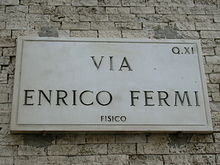 This street in Rome commemorates Enrico Fermi
This street in Rome commemorates Enrico Fermi
Some streets are named after famous or distinguished individuals, sometimes people directly associated with the street, usually after their deaths. Bucharest's Şoseaua Kiseleff was named after the Russian reformer Pavel Kiselyov who had the road built while Russian troops were occupying the city in the 1830s; its Strada Dr. Iuliu Barasch is named after a locally famous physician whose clinic was located there.
Naming a street after oneself as a bid for immortality has a long pedigree; Jermyn Street in London was named by Henry Jermyn, 1st Earl of St Albans, who developed the St. James's area for Charles II of England. Perhaps to dissuade such posterity-seeking, many jurisdictions only allow naming for persons after their death, occasionally with a waiting period of ten years or more. A dozen streets in San Francisco, California's North Beach neighborhood were renamed in 1988 after local writers; in 1994, the city broke with tradition, honoring Lawrence Ferlinghetti by renaming an alley after him within his own lifetime.[3]
Naming a street for a person is very common in many countries, often in the honoree's birthplace. However, it is also the most controversial type of naming, especially in cases of renaming. It is often the main reason for renaming:
- to commemorate a person who lived or worked in that area (for example, Avenue Victor Hugo in Paris, where he resided);
- to rename a very important street in a city after a major historical figure (for example, Boulevard René Lévesque in Montreal, formerly Dorchester Boulevard and Boulevard Leopold III / Leopold III Laan in Brussels named after a previous King).
Conversely, it can be a way to eliminate a name that proves too controversial; for example, Hamburg Avenue in Brooklyn, New York became Wilson Avenue after the United States entered World War I against Germany (see below).
Themes
Groups of streets in one area are sometimes named using a particular theme. One example is Philadelphia, where the major east-west streets in William Penn's original plan for the city carry the names of trees.
Other examples of themed streets:
- In Washington, D.C., each of the 50 U.S. states has a street named after it (such as Pennsylvania Avenue, which runs from the Capitol to the White House). The state-named streets cross diagonally through the alphabetic (East-West) and numbered streets (North-South) in Washington's grid (see Streets and highways of Washington, D.C.).
- Many American cities feature the names of presidents and states in their street names. In Mason City, Iowa, for example, the west and east sides of the city are divided by the Federal Avenue. West of the Federal Avenue, streets are named Washington Avenue, Adams Avenue, Jefferson Avenue, ..., to Eisenhower Avenue. East of the Federal Avenue, streets are named Delaware Avenue, Pennsylvania Avenue, Georgia Avenue, ..., to California Avenue.[4]
- Themed street names are very common in Guadalajara, Mexico; themes include:
- Constellations and astronomers in La Calma and Arboledas.
- Rivers and mountain ranges in Las Águilas (Sierra de Pihuamo, Río Verde...)
- Aztec places, people and gods in Ciudad del Sol (Axayácatl, Cuauhtémoc, Popocatépetl, Anáhuac...)
- World cities in Providencia.
- Hispanic writers and intellectuals in Ladrón de Guevara and nearby areas.
- Flowers in downhill Bugambilias, animals uphill.
- Classical artists in La Estancia (Hector Berlioz, Rafael Sanzio, Johann Sebastian Bach...)
- International writers in Jardines Vallarta.
- Mexican isles near El Sauz.
- Countries in Colonia Moderna (Francia, España, Alemania...)
- In Denver, Colorado, most north-south streets are named in alphabetical order, beginning Albion-Ash-Bellaire-Birch-Cherry-Clermont going eastward, and Acoma-Bannock-Cherokee-Delaware-Elati-Fox going west.
- In New Orleans, Louisiana, many streets of the historic French Quarter are named for royal houses of France. Many who visit this neighborhood mistake Bourbon Street to be named after the beverage that many of the street's famous revelers are drinking, while it is actually named after the House of Bourbon, the ruling dynasty of France when the city was founded. (Bourbon whiskey is named for Bourbon County, Kentucky, and thus also indirectly for the dynasty.)
- The Toxteth area of Liverpool has 'Welsh Streets', a series of streets named after Welsh places, including Rhiwlas St, Gwydir St, Powis St and Madryn Street, where Beatles drummer Ringo Starr grew up. These streets are in the process of being demolished in order to create a more modern housing development. This has been heavily opposed by local residents, who claimed demolition would break Liverpool's link with Wales[5] and ruin a piece of Beatles history.[6]
- Worcester has two themed areas where streets are named after large cities in Australia and Canada. Leicester has one area named after nuts, with Filbert Street being the home of Leicester City F.C. between 1891 and 2002.
- Leicester also has a series of terraced streets with the names Hawthorne, Alma, Rowan, Ruby, Ivanhoe, Sylvan, Oban, and Newport, forming an acrostic for Harrison, the name of the builder. The streets all run into Beatrice Road, named for the builder's wife.
- Streets in the Central Business District of Sydney, Australia, are often named after English counties, regions or towns, including Sussex Street, Kent Street, York Street, Liverpool Street, Gloucester Street and Cumberland Street.
- In Brossard, Quebec, and Brampton, Ontario, different sections of the town all have streets starting with the same letter; in Brampton, the alphabetical order reflects chronology. Laval, Quebec has an area named for birds; Kirkland, Quebec has an area named after wines.
- In the Barcelona Olympic Village, built for the 1992 Summer Olympics, the streets are named after cities that have hosted Olympics in the past.
- Several cities have areas named for the characters in Robin Hood: Mississauga, Ontario; Markham, Ontario; Memphis, Tennessee; Winston-Salem, North Carolina; Atlanta, Georgia.
- Themed names are popular in suburban subdivisions. The subdivision or suburban town may itself give the name of the theme, such as Anjou, Quebec (ex: main street named for King René of Anjou) and Lorraine, Quebec (streets all named for towns in eastern France, main street named for Charles de Gaulle, who resided in that part of France).
- All street names in the Sampaloc District of northeast Manila, Philippines, are taken from the life and writings of José Rizal.
- All streets in the South Triangle District of Quezon City, Philippines, were named in honor of the Boy Scouts who died in a plane crash en route to the 11th World Scout Jamboree in Greece.
- Street names in Canberra typically follow a particular theme: the streets of Duffy are named after Australian dams and weirs, the streets of Page are named after biologists and naturalists, and the streets of Gowrie are named after Australian recipients of the Victoria Cross.
- Almere, Netherlands, a planned city founded in 1976, is separated into themed sections. Streets in the city's business district are named for occupations (merchant, poet, real estate agent). Streets in other neighborhoods are named for musical instruments, actors, film directors, islands, months of the year, days of the week, rock stars (Rolling Stones, Jimi Hendrix), fruits, electronics (transistor, microphone, television), and even Dutch comic-book characters. Themed street names are also very common in all other Dutch towns and cities. It is rare to find non-themed neighborhoods built after 1900 in the Netherlands.
- Nearly all of the streets in Leeton, Australia were named after plants.
- The Belgrade, Serbia neighborhood of Cerak Vinogradi has streets named exclusively by the tree species that lines the street: Ash, Linden, Cedar, etc. Notably, the only non-tree place name is the central green space area, named "Trg (Square of) S.C. Babovic", though it lacks any signs with the name.
- Street names in Iceland usually follow a duo-theme, where the second element is common throughout a neighborhood. Examples include neighborhoods where the themes are the names of early settlers, ending with -gata (street); and natural themes where the second part is -smári (clover) or -gerði (hedge) and the first part is chosen with alphabetic order in mind.
- San Francisco has five partial alphabets of parallel streets. Three of these series form the grid in the Bayview district (the series Griffith ... Upton crosses the double series Arthur ... Yosemite, Armstrong ... Meade). Another (Anza ... Yorba) crosses the numbered Avenues in the Richmond and Sunset districts, which together are sometimes called "The Avenues". A fifth is the north-south streets of the Sunnyside district (Acadia ... Genesee). San Francisco also has a series of numbered Streets in the Mission and South-of-Market districts.
- Grantham, England; an estate, located in the northeast of the town, has its streets named after famous golf courses and racecourses located around the United Kingdom and the Republic of Ireland, with a few exceptions. The estate itself is named "The Fairways" after the middle section of a golf hole.
- In Saskatoon, Saskatchewan, the city's west side has avenues that go from A-Z, although the majority of Avenue A was renamed to "Idylwyld Drive", a portion of the old Ave. A goes from 19th to 20th streets and will expand to an extension of Spadina Crescent in the River Landing development. Although it was not officially named, Witney Avenue in the Meadowgreen and Mount Royal neighborhoods has been unofficially dubbed Avenue Z since it is the last street which runs parallel to Avenue Y.
- In Gander, Newfoundland, every street is named after a pilot, honoring the town's aviation history.
- Downtown of Ljubljana, Slovenia, has a grid system of roads and Ljubljanica river banks named after famous Slovenian writers, poems or artists, such as France Prešeren and Ivan Cankar. A neighbourhood named Murgle (in Southern Vič district) contains a street naming system based on names of trees planted on sides of the streets, e.g. Under Maples, Under Oaks and Under Willows.
- Streets, squares and parks in Cervar-Porat, Croatia, are named after winds, e.g. Jugo square, Bura square and Maestral park; after mediterranean plants and trees, e.g. Lavanda, Oleander, Maslina, Bršljan, Ružmarin; and after some objects such as anchor and amphora. Stradun street is named after main street in Dubrovnik. Skalinada street is named after Croatian urbanism term of a stairway street.
- In Palo Alto, California, streets in the College Terrace neighborhood (which borders the Stanford University campus) are named after distinguished colleges and universities. The streets running north-south start at the westernmost end of the neighborhood alphabetically: Amherst, Bowdoin, Columbia, and Dartmouth. After Dartmouth, the streets do not follow the alphabet (except for the last streets, Wellesley, Williams, and Yale): Hanover, Harvard, Oberlin, Princeton, and Cornell. The backbone of the neighborhood running west-east is College Avenue, and the northernmost street, Stanford Avenue also runs west-east.
- In downtown Anchorage, Alaska, north-south streets east of A Street are named after Alaskan communities and place names, starting with Barrow, Cordova, Denali, Eagle. West of A street, streets are merely lettered; as in Washington D.C., they skip J street. Most east-west avenues are numbered.
- In Milford, Massachusetts, there is one section of collegiate names (Purdue, Cornell, Bowdoin, etc.
- In Amarillo, Texas, downtown north-south streets are named for Texians who died during the Battle of the Alamo, followed by the San Jacinto area with streets named after the states of the Confederate States of America. In addition, the Eastridge neighborhood features streets named with flower-inspired names, in alphabetic order.
Grid-based naming systems
In many cities laid out on a grid plan, the streets are named to indicate their location on a Cartesian coordinate plane. For example, the Commissioners' Plan of 1811 for Manhattan provided for numbered streets running parallel to the minor axis of the island and numbered and lettered avenues running parallel to the long axis of the island, although many of the avenues have since been assigned names for at least part of their courses. In the city plan for Washington, D.C., north-south streets were numbered away from the United States Capitol in both directions, while east-west streets were lettered away from the Capitol in both directions and diagonal streets were named after various States of the Union. As the city grew, east-west streets past W Street were given two-syllable names in alphabetical order, then three-syllable names in alphabetical order, and finally names relating to flowers and shrubs in alphabetical order. Even in communities not laid out on a grid, such as Arlington County, Virginia, a grid-based naming system is still sometimes used to give a semblance of order.
Often, the numbered streets run east-west and the numbered avenues north-south, following the style adopted in Manhattan, although this is not always observed. In some cases, streets in "half-blocks" in between two consecutive numbered streets have a different designator, such as Court or Terrace, often in an organized system where courts are always between streets and terraces between avenues. Alternatively, some systems use fractions or additional letters (such as 38th 1/2 Street or 38a Street for a street between 38th and 39th). Sometimes yet another designator (such as "Way", "Place", or "Circle") is used for streets which go at a diagonal or curve around, and hence do not fit easily in the grid.
In many cases, the block numbers correspond to the numbered cross streets; for instance, an address of 1600 may be near 16th Street or 16th Avenue. In a city with both lettered and numbered streets, such as Washington, D.C., the 400 block may be between 4th and 5th streets or between D and E streets, depending on the direction in which the street in question runs. However, addresses in Manhattan have no obvious relationship to cross streets or avenues, although various tables and formulas are often found on maps and travel guides to assist in finding addresses.
Examples of grid systems:
- In Denver, all roads running east/west are given "Avenue" designations, while those running north/south are given "Street" designations. Sometimes, additional designations are given based on physical characteristics of the road (for example, 6th Avenue Parkway and Monaco Street Parkway both contain large medians consisting of trees and walkways). Denver carries numbered Avenues north of Ellsworth, the center of the address system in Denver. Broadway carries alphabetical streets east and west. For example, 100 North Broadway is at First Avenue and Broadway. Alternately, 100 West Ellsworth is at Ellsworth and Acoma Street.
- In Salt Lake City, the road system is generally based on the location of Temple Square. Salt Lake City is also known to have a number-based naming system. For example, one may find the address of a local store at 4570 South 4000 West, where 4000 West (or 40th West) is the name of the street and 4570 is the number on the building. This means the store is approximately 45 blocks south of the Salt Lake LDS Temple, and 40 blocks west of the Salt Lake Temple. Similar cartesian coordinate systems are used in other Utah cities and towns. Much of rural Indiana follows the same practice, as do many cities and towns in eastern Idaho.
- The Chicago grid system extends throughout the entire city and into some of its suburbs. State Street (0 E/W) and Madison Street (0 N/S), in the "Loop" divide the city into quadrants. All streets bear a directional prefix (N, S, E or W) indicating their position relative to State and Madison, which is never omitted when writing an address (and rarely in speech). "Blocks", which have a range of 100 numbers, are approximately 1/8 mile long (except between Madison and 31st Streets, where blocks are slightly shorter). Many neighborhoods have intermediate blocks at 1/16 mile intervals as well. Most high-traffic streets lie at intervals of a mile or half-mile. North-south streets are always named, while east-west streets are named on the North Side and numbered on the South Side. Most residents know at least a few of the major streets and their grid positions (i.e. North Avenue = 1600 N, Cicero Avenue = 4800 W). Thus addresses in Chicago are commonly given two ways: in Cartesian coordinates (3400 North, 2800 West) or as number and name (3324 North California). The distance from State or Madison Streets can be calculated from the address number, dividing by 800. For example, 1600 north is two miles north of Madison and 1600 west is 2 miles west of State. Diagonal streets are given directional suffixes based on whether they travel more north-south or more east-west. Examples are North Lincoln Avenue and Ogden Avenue, which bends at Madison and changes from North Ogden to West Ogden.
- In Detroit and the suburbs to the north, major roads were generally built every mile, and many of the east-west roads are numbered in the Mile Road System based on their distance from the start of Woodward Avenue. These roads are named with "Mile Road", from 5 Mile to 37 Mile. Addresses in much of the area are counted from the beginning of Woodward Avenue in Detroit, with roughly 2000 addresses assigned per mile, not coinciding with the Mile Road numbers; for instance, 8 Mile is the 20700 block, not 800 or 8000.
Street renaming
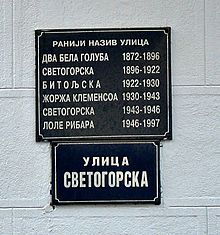 Names are sometimes changed for political purposes. A Belgrade street that began as "Two White Doves" in 1872 was renamed Svetogorska in 1896, Bitoljska in 1922, for Georges Clemenceau in 1930, Svetogorska again in 1943, for Lola Ribar in 1946, and Svetogorska again in 1997.
Names are sometimes changed for political purposes. A Belgrade street that began as "Two White Doves" in 1872 was renamed Svetogorska in 1896, Bitoljska in 1922, for Georges Clemenceau in 1930, Svetogorska again in 1943, for Lola Ribar in 1946, and Svetogorska again in 1997.
Street names can usually be changed relatively easily by municipal authorities for various reasons. Sometimes streets are renamed to reflect a changing or previously unrecognized ethnic community or to honour politicians or local heroes.
A changed political regime can trigger widespread changes in street names – many place names in Zimbabwe changed following independence in 1980, replacing names of British colonists with those of Zimbabwean nationalist leaders.
Street names may also be changed to reflect gradual changes in political attitudes, for example in Atlanta, Georgia where streets named after the city's early settlers - many of whom were secessionists and slaveholders - have been renamed gradually since 1990, mostly for civil rights leaders.[7][8]. While the older street names consisted of last names only (e.g. Hunter Street, Cain Street, Ashby Street), the new names include the full name of the honoree (e.g. Joseph E. Lowery Blvd., Ralph David Abernathy Blvd., Martin Luther King, Jr. Blvd.)
Some international causes célèbres can attract cities around the world to rename streets in solidarity; for example a number of streets with South African embassies were renamed honouring Nelson Mandela during his imprisonment.
Street names can also be changed to avoid negative associations. Malbone Street in Brooklyn, New York City, became Empire Boulevard after the deadly Malbone Street Wreck. Cadieux Street in Montreal was renamed De Bullion because the original name was notorious for the former presence of many bordellos. East 14th Street in Oakland, California, which was notorious for extreme levels of violent crime, was renamed International Blvd in 1996 as part of the city's redevelopment efforts. Prohibition brought about heated attempts to change Whiskey Bottom Road in Laurel, Maryland, to a more "dignified" name.[9] During World War I several streets in the German Village area of Columbus, Ohio, were given more "American" sounding names, and Hamburg Avenue in Brooklyn became Wilson Avenue. In Toronto, Hamburg Avenue was renamed to Bristol Avenue in one part and made into an extension of Gladstone Avenue in another. Streets named for Humboldt, Liszt and Schiller were renamed Lynwood, Balmoral and Clarendon, respectively, while Bismark Avenue became Asquith.
 Street name in English and French on Guernsey.
Street name in English and French on Guernsey.
 Street name in French and Catalan, Perpignan
Street name in French and Catalan, Perpignan
Street names also can be affected by a change in official language. After the death of Francisco Franco, the Spanish transition to democracy gave Catalonia the status of an autonomous community, with Catalan as a co-official language. While some street names in Catalonia were changed entirely, most were merely given the Catalan translations of their previous Castilian names; for example, Calle San Pablo (Saint Paul Street) in Barcelona became Carrer Sant Pau. In some cases, this was a reversion to Catalan names from decades earlier.
In a similar way, English street names were changed to French in Quebec during the 1970s, after French was declared the sole language for outdoor signage. This was met with hurt and anger by many of the province's Anglophones, who wished to retain their traditional placenames. The government body responsible for overseeing the enacting of the Charter of the French Language continues to press English-majority communities to further francize their street names (for example, what was once "Lakeshore Road" was changed to "Chemin Lakeshore" in the 1970s, with the Office québécois de la langue française pressuring a further change to "Chemin du Bord-du-Lac"). However, some Indian reserves have their own signage policies, which may exclude French.
Sometimes, when communities are consolidated, the streets are renamed according to a uniform system. For example, when the community of Georgetown ceased to have even a nominal existence independent of Washington, D.C., the streets in Georgetown were renamed as an extension of Washington's street-naming convention. Also, when leaders of Arlington County, Virginia, asked the United States Post Office Department to place the entire county in the "Arlington, Virginia" postal area, the Post Office refused to do so until the county adopted a uniform addressing and street-naming system, which the county did in 1932.
In the borough of Queens, New York, a huge street renaming campaign began in the early 20th century, changing almost all of the street names into numbers, in accordance with the adoption of a new unified house numbering scheme. A confusing aspect of this massive transformation was that some of the local subway stations retained their names, instead of them being changed with their corresponding street(s). Often these names either remained intact years later, with rare examples surviving even today. A curious example is that of 23rd Street - Ely Avenue Station; Ely Avenue was renamed 23rd Street long before the subway station was even constructed.
 Pre- (top) and post-1993 (bottom) street signs in Bucharest, showing the two different spellings of the same name
Pre- (top) and post-1993 (bottom) street signs in Bucharest, showing the two different spellings of the same name
Sometimes street renaming can be controversial, because of antipathy toward the new name, the overturning of a respected traditional name, or confusion from the altering of a familiar name useful in navigation. A proposal in 2005 to rename 16th Street, N.W., in Washington, D.C., "Ronald Reagan Boulevard" exemplified all three. Issues of familiarity and confusion can be addressed by the street sign showing the current name and, in smaller writing, the old name. One compromise when the issue is more political can be "co-naming", when the old name is fully retained but the street is also given a second subsidiary name, which may be indicated by a smaller sign underneath the 'main' name. (See section below on "Multiple names for a single street".)
It is also controversial because it is seen by many as a way to rewrite history, even if the original name is not well-liked but nevertheless traditional or convenient. It can be used to erase the presence of a cultural group or previous political regime, whether positive or negative, and to show the supremacy of a new cultural group or political regime. A prime example of this type of name change was the renaming of Montreal's Dorchester Boulevard, the nexus of the financial and business district, named for governor Lord Dorchester, to René Lévesque Boulevard, after a leader of the Parti Québécois, a separatist party which was responsible for diminishing the rights of anglophones throughout the province (including mandating French-only street names)[neutrality is disputed]. City officials rushed to the name change, without even waiting the required one-year mourning period after Lévesque's death.[citation needed] Many Anglophones and federalists were outspoken in their opposition to the name change, and the majority English-speaking city of Westmount retained Dorchester as the name of their portion of the street in protest.
Multiple names for a single street
 The section of St. Joseph Street running through Toronto's University of St. Michael's College is co-named Marshall McLuhan Way.
The section of St. Joseph Street running through Toronto's University of St. Michael's College is co-named Marshall McLuhan Way.
While it is very common for what is effectively a single street to have different names for different portions of the street, it is less common for a portion of a street to have two equally acceptable legal names. There are numerous cases of the latter in New York City: Sixth Avenue in Manhattan was renamed as Avenue of the Americas in 1945, but the name never really stuck, and the city now considers both names equally acceptable, and both appear on street signs. Manhattan street signs now also designate a portion of Seventh Avenue as Fashion Avenue, and Avenue C is also Loisaida Avenue, a Spanglish name deriving from the English Lower East Side. In Harlem, 125th Street is co-named Dr. Martin Luther King Jr. Blvd while East 116th Street also bears the name Luis Munoz Marin Blvd. The avenues also bear co-names: Lenox (Sixth) Avenue/Malcolm X Blvd, Seventh Avenue/Adam Clayton Powell Blvd, and Eighth Avenue/Frederick Douglass Blvd. One street in the Wakefield neighborhood of the Bronx changes its name repeatedly due to the presence of the Bronx - Mount Vernon border, from South 11th Avenue in Mount Vernon, eventually becoming Seton Avenue in the Bronx, with one particular section in between having different names on each side of the street because of the presence of the city line in the centre line of the street: Seton Avenue on the west (Bronx) side of the street, and Mundy Lane on the east (Mount Vernon) side of the street. As a result of this confusing nomenclature created by the difference in jurisdiction, many city maps display both names without giving further visual clarification regarding the name difference, while some other maps give no specific name whatsoever to that portion of the street, instead opting to label the street South 11th Avenue for the portion of the street entirely in Mount Vernon, and Seton Avenue in the Bronx, negelecting to mention Mundy Lane in between.
Cairo's Muizz Li-Din Allah Street changes its name as one walks through. It may variously be referred to by locals as Souq Al-Nahhasin ("Coppersmith Bazaar") or Souq Al-Attarin ("Spices Bazaar") or Souq Al-Sagha ("Goldsmith and Jeweler Bazaar"), according to historical uses, as in "Type of commerce or industry" above. (For a tourist, that might be misleading. These Cairene names identify both a "segment" within the Street, and "sub-Areas" in the City.)[10]
In Australia, some major roads may have two names of different types:
- Hume Highway/Sydney Road in outer northern Melbourne, which is exclusively Sydney Road closer to the city and exclusively the Hume Highway outside Melbourne
- Hoddle Highway which is better known as Hoddle Street north of Bridge Road and Punt Road south of it
- Princes Highway which has localised names - Dandenong Rd through South-Eastern Melbourne; Geelong Rd through the Western suburbs and Lonsdale Street through central Dandenong. The reason for this confusing naming of the highway is that it follows streets and roads which were already named when the highway was named in 1920 and were never renamed.
- Nepean Highway which adopts the name Brighton Rd, St Kilda Road, and finally Swanston Street
Boundary Road/Station Road in Hove and Portslade, East Sussex, has different names for each side of the street. Originally known as "Station Road", named for Portslade railway station, in 1903 Hove opted to rename its side as "Boundary Road", to avoid confusion with "Station Approach", leading to Hove railway station. Portslade's parish council objected to this, and continued to refer to their side by the old name.
Some cities may use double-naming to honour historic street names. In Calgary, Alberta, for instance, most downtown streets were originally named after local pioneers, but in the early 1900s the original names were replaced by numbers. Decades later, some of the original street names were reincarnated as names for pedestrian or other malls. These names are not used in addressing: a building on the Stephen Avenue Mall would still have its legal address on 8th Avenue SW or SE.
Multiple streets sharing the same name
In many cases, more than one street in a locality will have the same name: for example, there are three separate Abbey Roads in London, and five Washington Streets in Boston.
In areas where people commonly refer to a street name with both "specific" and "generic" parts solely by the specific one, this can cause additional confusion. For example, Atlanta has many streets that share the name Peachtree Street, -Drive, -Plaza, -Circle, -Way, -Walk, West Peachtree Street, and many other variations that include "Peachtree" in the name. Occasionally, these streets actually intersect each other, as with Pike Place and Pike Street and Ravenna Boulevard and Ravenna Avenue in Seattle, Washington. In many cities in Alberta, new developments have only a few common street names, which are followed by variant types such as Boulevard, Drive, Crescent and Place. The western suburbs of Philadelphia near Conshohocken contain a number of roads named Gulph, including Gulph Road, Upper Gulph Road, New Gulph Road, Old Gulph Road, Gulph Creek Road, Gulph Lane, Gulph Hills Road, North Gulph Road, and South Gulph Road. In some cases, these roads intersect each other multiple times, creating confusion for those unfamiliar with the local geography.
Such an occurrence of street names coinciding came in the episode "The Maid" on Seinfeld, when a lost Kramer, calling Jerry for assistance, discovers he is at the corner of 1st Avenue and 1st Street in New York. He remarks, "1st and 1st. The nexus of the universe."
Nicknames and shorthands
Some streets are known equally or better by a name other than their official name.
Seattle's University Way NE is almost universally known to locals as "The Ave".[11] Buffalo, New York's Delaware Avenue acquired the nickname of "Presidents Avenue", being where Millard Fillmore lived, William McKinley died, and Theodore Roosevelt was sworn in as president. The best-known segment of South Las Vegas Boulevard is called the Las Vegas Strip, or just "The Strip".
It is also common in some places to shorten the name of streets which have long names. For example, many streets named for Massachusetts are often referred to as "Mass Ave"; Boston's Commonwealth Avenue is often called "Comm Ave"; Manhattan's Lexington Avenue is often simply called "Lex" and Madison Avenue, "Mad"; Charlottesville, Virginia's Jefferson Park Avenue is simply "JPA"; in Williamsburg, Virginia, Duke of Gloucester Street is often referred to as "DOG Street". In Chicago, Lake Shore Drive is commonly abbreviated to "LSD".[citation needed] In Portland, Oregon, Martin Luther King, Junior Boulevard is abbreviated to "MLK Jr. Blvd." (although in Chicago, Martin Luther King, Jr. Drive is always called "King Drive"), and the Tualatin Valley Highway west of Portland is often spoken of and written as "TV Highway". In Toronto, the Don Valley Parkway is commonly referred to as the "DVP" (and sometimes the Don Valley Parking Lot due to high congestion). In Los Angeles, Figueroa Street is frequently referred to as "Fig.", and in southern California, "PCH" is a common abbreviation for Pacific Coast Highway. In Las Vegas, Desert Inn Road and Tropicana Avenue are known to the locals as "D.I." and "Trop", respectively, plus Martin Luther King Boulevard there is known as "MLK".
In Paris, Boulevard Saint-Michel is affectionately known as "Boul'Mich". North Michigan Avenue, Chicago's most famous shopping street, is also occasionally referred to by that name, but is more commonly called the Magnificent Mile.
Symbolism
Some street names in large cities can become metonyms, and stand for whole types of businesses or ways of life. "Fleet Street" in London still represents the British press, and "Wall Street" in New York City American finance. In London, a top surgeon with a private practice is liable to be referred to as a Harley Street surgeon even if he does not actually maintain an office in Harley Street. The cachet of streets like Park Avenue and Fifth Avenue can prove effective branding, as for the Buick Park Avenue luxury car, and Saks Department Store being always known as "Saks Fifth Avenue". In the opposite way, 42nd Street still symbolizes a street of pleasure, but also sin and decadence. Like Wall Street, Toronto's Bay Street represents Canadian finance and business and still serves it today.
Much as streets are often named after the neighborhoods they run through, the reverse process also takes place, with a neighborhood taking its name from a street or an intersection: for example, the aforementioned Wall Street in Manhattan, Knightsbridge in London, Haight-Ashbury in San Francisco, or Jane and Finch in Toronto.
Vanity addresses
A street address invented or renamed to emphasize a particular institution is sometimes called a "vanity address".[12]
- One example is Target Field in Minneapolis, Minnesota, whose address is styled as "1 Twins Way". The home stadium of the Minnesota Twins baseball team is at the foot of "Twins Way", which is a renamed, short portion of 3rd Avenue.
- The Palace of Auburn Hills is addressed as "6 Championship Drive" to recognize the number of championships sports teams who play there have won. (3 for the Detroit Pistons and 3 for the Detroit Shock).
Street type designations
Streets can be divided into various types, each with their own general style of construction and purpose. However, the difference between streets, roads, avenues and the like is often blurred and is not a good indicator of the size, design or content of the area. For example, London's Abbey Road serves all the vital functions of a street, despite its name, and locals are more apt to refer to the "street" outside than the "road". A desolate road in rural Montana, on the other hand, may bear a sign proclaiming it "Davidson Street", but this does not make it a "street".
In the United Kingdom many towns will refer to their main thoroughfare as the High Street, and many of the ways leading off it will be named "Road" despite the urban setting. Thus the town's so-called "Roads" will actually be more streetlike than a road.
In some other English-speaking countries, such as New Zealand and Australia, cities are often divided by a main "Road", with "Streets" leading from this "Road", or are divided by thoroughfares known as "Streets" or "Roads" with no apparent differentiation between the two. In Auckland, for example, the main shopping precinct is around Queen Street and Karangahape Road, and the main urban thoroughfare connecting the south of the city to the city centre is Dominion Road.
In Manhattan and Seattle, east-west streets are "Streets" whereas North-South streets are "Avenues". Yet in St. Petersburg, Florida and Memphis, Tennessee, all of the east-west streets are "Avenues" and the North-South streets are "Streets" (Memphis has one exception—the historic Beale Street runs east-west).
In Ontario, concession roads are numbered based on where in an area's initial survey they are located. Roads perpendicular to the baseline, usually a lake, are often called "lines", while roads parallel to the baseline are either "concession roads" or "sideroads".
In Montreal, "Avenue" (used for major streets in other cities) generally indicates a small, tree-lined, low-traffic residential street. Exceptions exist, such as Park Avenue and Pine Avenue. Both are major thoroughfares in the city. In older cities, names such as "Vale" which would normally be associated with smaller roads may become attached to major thoroughfares as roads are upgraded (e.g. Roehampton Vale).
In the Netherlands in the 1970s and 1980s[13] there was a trend to not use the street type suffix at all, resulting in street names like (translated) "North Sea" and "Tuba".
 The word "Street" is omitted on the sign for Kearny Street in San Francisco; this is standard throughout the city.
The word "Street" is omitted on the sign for Kearny Street in San Francisco; this is standard throughout the city.
In some cities in the United States (San Francisco; Houston; Detroit; Cleveland; Memphis), streets have official suffixes, but they are not generally given on street signs or used in postal addresses. In Chicago, suffixes are given on street signs but often ignored in popular speech, postal addresses, and 'L' station names.
Occasionally, in systems where the general trend is to omit street type suffixes, there may be specific execptions where the street type is included, when the name of a street may cause confusion for those unfamiliar with the region. For example, in Toronto, where public transit services, such as bus routes, streetcar routes, and subway station names, tend to omit street type suffixes, "Main Street" is always referred to as such because visitors might assume that it is a central thoroughfare in the city, when in fact it is far removed in the east side, in the former town of East Toronto, which was annexed by Toronto in 1908. It was never renamed because there were no other "Main Streets" for it to conflict with, since Toronto's main thoroughfare is named Yonge Street.
List of street type designations
See also: Street suffixIn parentheses for each designation are listed the standard abbreviation used in the U.S.[14]
- Major roads
- Controlled-access highway (Hwy.) or Motorway (Mtrwy.)
- Main roads (e.g. A roads in Great Britain)
- A road
- Bundesstraße
- Expressway (Expy.)
- Freeway (Fwy.)
- Pike
- Reichsstraße
- Small roads (often residential/suburban)
- Alley (Aly.)
- Arcade
- Avenue (Ave.)
- Boulevard (Blvd.)
- Road (Rd.)
- Street (St.)
- Bay
- Drive (Dr.)
- Close
- Gardens (Gdns.)
- Gate
- Glebe
- Lane (Ln.)
- Manor (Mnr.)
- Mews (*Not often used)
- Nene (*Not often used)
- Passage (Psge.)
- Pathway (Pthwy.)
- Place (Pl.)
- Row
- Terrace (Ter., or Tce in Australia)
- Trace (Trce.)
- Trail (Trl.)
- View (Vw.)
- Way
- Culs-de-sac
- Named for their shape
- Named for geographical attributes
- Named for their function
Numbering
Some major roads, particularly motorways and freeways, are given road numbers rather than, or in addition to, names. Examples include the M1 and Interstate 5. Many streets in Britain are given both a number and a name as part of the Great Britain road numbering scheme. The same is also common in the United States; for example, in Washington, D.C., much of New York Avenue is U.S. Highway 50. In York Region, Ontario, the former provincial Highway 7 (currently signed as York Regional Road 7) is still referred to as Highway 7 on road signs and in everyday use, even though the road has not been part of Ontario's provincial highway system since 1998.[15]
Some jurisdictions may use internal numbers to track county or city roads which display no number on signs.
Statistics
The most common street names in the United States, as of 1993, were:
- Second or 2nd (10,866)
- Third (10,131)
- First (9,898)
- Fourth (9,190)
- Park (8,926)
- Fifth (8,186)
- Main (7,644)
- Sixth (7,283)
- Oak (6,946)
- Seventh (6,377)
- Pine (6,170)
- Maple (6,103)
- Cedar (5,644)
- Eighth (5,524)
- Elm (5,233)
- View (5,202)
- Washington (4,974)
- Ninth (4,908)
- Lake (4,901)
- Hill (4,877)[1]
"First" streets are less common than "Second" and "Third" because some cities do not have "First" streets—naming them "Main" instead, or renaming them after historical figures.[1]
See also
- Numbered street
- Road designation
- Street sign
References
- ^ a b c Census and You, February 1993 (United States Census Bureau, Geography Division), as reported in "Most common street names", National League of Cities.[dead link]
- ^ "The Shambles" at Britain Express. Accessed 27 August 2005.
- ^ Adair Lara, Literary light: City Lights Bookstore, at 50, is showing few signs of aging, San Francisco Chronicle, June 5, 2003. Accessed on line December 22, 2006.
- ^ http://www.bing.com/maps/default.aspx?q=mason+city+iowa+streets+grid&mkt=en-US&FORM=BYFD#JnE9LmZlZGVyYWwlMmJhdmUlMjUyYyUyYm1hc29uJTJiY2l0eSUyNTJjJTJiaWElN2Vzc3QuMCU3ZXBnLjEmYmI9NDMuMTU1MDQ1NjUyNjQzJTdlLTkzLjE5NTc0MTMyNTExMzglN2U0My4xNTIwMDg4MDAxNjM4JTdlLTkzLjIwMDcyNDg2OTQ2MzU=
- ^ http://www.walesonline.co.uk/tm_objectid=16159775&method=full&siteid=50082&headline=farewell-liverpool-s-welsh-streets-name_page.html
- ^ http://www.liverpooldailypost.co.uk/liverpool-news/regional-news/2007/11/09/residents-pleas-ignored-over-welsh-streets-plans-64375-20084377/
- ^ http://cascade.patch.com/articles/cascades-history-of-renaming-streets-honoring-confederate-generals-others
- ^ http://www.11alive.com/news/article/201659/3/UPDATE-Debate-over-changing-street-name-exposes-secrets-scars
- ^ "Whisky Bottom Rd. In Laurel Becomes Patuxent Drive". The Washington Post: p. 1. November 26, 1950.
- ^ Daniel Lanier, Bazaar of the Tentmakers, Shopping around Egypt, accessed 12 March 2006.
- ^ Paul Dorpat, "Seattle Neighborhoods: University District -- Thumbnail History", HistoryLink, June 18, 2001 (updated May 2002), accessed 12 March 2006.
- ^ http://www.newyorker.com/talk/2007/11/12/071112ta_talk_mcgrath
- ^ Cüsters, J: "Straatnaamcommissie piekert zich suf", Binnenlands Bestuur, 25 September 1998.
- ^ http://www.usps.com/ncsc/lookups/abbreviations.html#suffix
- ^ Caroline Grech (2007-07-07). "Would you rather drive on Ave. 7?". Yorkregion.com. http://www.yorkregion.com/News/Markham/article/36094. Retrieved 2007-07-08.
External links
- National Emergency Number Association (NENA)
- National Emergency Number Association (NENA) road naming and numbering standards at Sussex County, Delaware
- Toronto street naming/renaming
- Draft Urban & Regional Information Systems Association (URISA) Street Address Data Standard
- United States Postal Service Street Name Suffix List
- United States Postal Service Pub. 28 - Postal Addressing Standards
- Street name prefixes and suffixes, definitions
Categories:- Odonyms
Wikimedia Foundation. 2010.

